|
This installment of Bill Netzeband's "Control Line Capers" column
in a 1962 edition of American Modeler magazine is the earliest
instance I remember discussing what relationship - if any- the location
of the bellcrank in the fuselage has with the models center of gravity
(CG). As it turns out, and elementary
physics would suggest it, the determining factor it the location
of the leadout line guides on the wingtip that is important to flight
characteristics. The wingtip leadout guides act only as a pair of
simple pulleys to change the direction of the applied force, so
once the line are past the guides, it does not matter to the airplane
where the pulley is located (assuming a rigid
airframe).
Control Line Capers:
Jul 61 |
Jan 62 |
Feb 62 |
Oct 62 |
Feb 63 |
Aug 63 |
Oct 63
| Dec 63
Wild Bill Netzeband's Control Line Capers
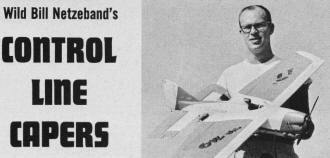
This time ... True Confessions, Relativity, Models and The Works.
[Pretty happy about our second contest attempt in many years: 3
firsts out of 3 (Stunt, RR & NC)! One of those days when you
just can't do anything wrong - to make up for lots of the other
kind. Wichita, Kans., July 1. Yes, there were other contestants.]
Misconception Blasted. Pictures illustrate that
the bellcrank has no effect on locating the CG. Rather, the bellcrank
should be on the CG to prevent binding (Pic #2). CG will always
fall in line with center of line lead-out spacing (1, 2 & 3)
during flight. Locate your lead-outs relative to the CG to produce
desired yaw angle for proper tug. We have settled, experimentally,
on a 6 degree rake. Proof later. Next time a guy tells you to locate
your CG forward of the BC or in front of the lead out, shun him.
He don't know the facts. The CG comes first, all else is related
to it.
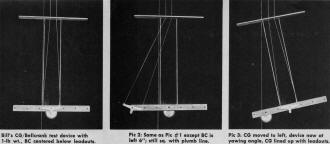
Bill's CG/Bellcrank test device with 1-lb weight,
Bellcrank centered below leadouts. Pic 2: Same as Pic #1 except
bellcrank is left 6"; still sq. with plumb line. Pic 3: CG moved
to left, device now at yawing angle, CG lined up with leadouts.
Scale Or Semi-Scale Stunt. Frank Beatty, 862
N. 73rd St., East St. Louis, Ill., in his Scale Column in "The Bulletin"
suggests cataloging model magazine data with index cards, cross-filed
by event, type, feature. Wish we'd started doing this a long time
ago. Hez also advocating Scale Stunt. If Frank and Charles Parrott
(Semi-Scale Stunt Team) will get together we might have the makings
of a new event.
Information Please? Two methods exist to gain
information ... research it yourself or accept some other's data.
I used to try the first method, but found it impossible to cover
the field. So we ask questions, and rely on (steal?) other folks'
combined knowledge. The manner of questioning is important. Rather
than "Man, you really stacked that in. KA-POW! Whajado? Lose it?"
- try "Excuse me, did they add a stem to that maneuver?" Be polite
but firm and clear. Also practice ducking fast ... very handy maneuver
sometimes.
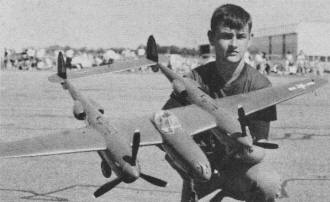
Junior event C/L scale winner at Westchester
(NY) Flying Fair: Dick McCuskor; two Fox 35's.
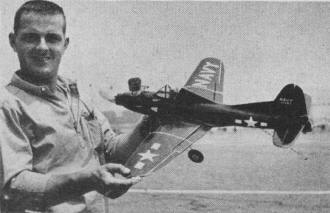
Navy Carrier WFF Junior champ: Bob Phillips with
35 1/2" 'McCoy 60 Mauler - also 1st at '61 Nationals.
How Fast Is Fast? To define or describe, we
reach into our experience and relate the action to similar actions
we have witnessed. You read our description. The words trigger your
memory and you relate as we did (but with your own experience).
Right now we're close to trouble. I said the ship was "quick" based
on 14 years of flying everything, but you have flown only trainers
and nose-heavy equip-ment. Didn't get together, did we?
Some day, sport fans, we'll describe it thusly, "The test model
using Brand X Flight Recorder (Ser 0071), configuration D3 in accordance
with test procedure Par 6.3 thru 6.14 - Model Aircraft Standards
Manuel - performed as follows:
Level flight speed, 106-mph. Time to reach maximum angle of attack
after application of 30 degrees elevator, 10 millisec. Time to complete
90° turn, 0.1 sec. Average turn rate, 900 degrees/sec. Minimum
turn radius, 10.2 feet. Model placed in Category C4 for reaction
to control command."
Whenever an absolute measurement can be made to compare with
a standard, no argument exists. Opinions always trigger discussion.
Presently all we possess is the stop watch, later we hope for better
test equipment. Until then we'll try to qualify our observations
clearly and hope to reach most of you as accurately as possible.
A sage once said, "The' best way to avoid mistakes is to do nothing".
Mid-America Stunt Championship. Sept. 2 at Lexington,
Ky. Lew McFarland (1961 Grand Nats Stunt Champ) judging, with trophies
to 5th place, some cash and a High Point Trophy. Also Scale Stunt
and as many flights as you can make. With John Peck and Lew officiating
it should be a grand day for all.
Sirotkin Stunter from Europe. The model while
following "classic" American lines is different in spots. Wing area
totals 620 with flaps, nose to tail moment arms 1:1.5, CG at 17%
root chord, stab-elev area 113-sq-in (18.3% wing), large fin area,
low ground angle - all these fit our present standard. Difference
is in homebuilt hardware: "X"-shaped bellcrank, one side for flaps,
other for elevator, spinner, control horns. Uses a .29 "Komet" engine
(like Russian combat types) on pen bladder tank swinging a 9-7/16
x 4 prop.
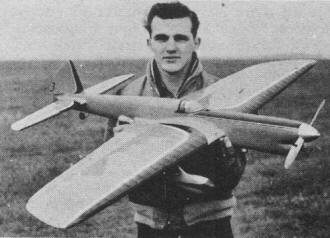
Modeler abroad: Texan "Jeep" Newman and Fox 35
"Ares." He was 2nd in British Nats two weeks later with its
modified stable mate.
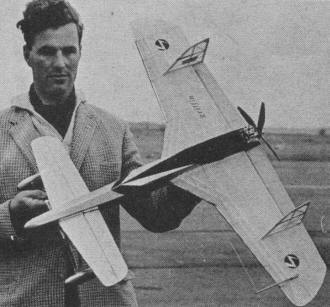
English kit maker and experimental canard stunter:
42", Glo-Chief 19, 4-blade 8/6'er, flaps, 39-oz.
Construction is sound and simple utilizing block-and-slab fuse
with "I" beam spar assembled "Detroiter"-style thru the fuse. Planking,
cap strips and the works indicate long life. Finally the airfoil
is 20-21% thick, reflexed curve style.
Miscellany. (1) During an average day of Rat Racing,
the good pilots travel (trot, run) 1.7 miles, if the ship runs 50
laps per tank. The pit crew travels a total of 30' (3 pit stops)
consisting of 5 feet after catching the ship and 5 feet back to
launch (if they move at all). Of course, the pit crew can also travel
several miles if the pilot ain't sharp.
(2) Help - Anyone got details (facts, figures, views) of the
German Gotha Bomber, the Breman, the Martin B-10, or the Barling
2 1/2 Wing Bomber? Contact Eddie Albers, 458 Pilgrim, San Antonio
13, Tex.
(3) Did you ever notice? A contest official thinks a contest
is a full day of frantic activity with no time for anything, while
a contestant thinks a contest is a day of boredom punctuated by
short periods of furious activity. Unless you are the Meriwether's
or Woody Blanchard.
(4) Flite Co., 6109 Pondarosa, NE, Albuquerque, New Mexico, has
a retractable landing gear set. Operation in 6-sec by servo power,
weight 2.2-oz, supports 9 1/2-lb R/C ship utilizing torsion rod
mounting. $29.95.
(5) Stanton Hobby Shop, 4734 N. Milwaukee Ave., Chicago 30, Ill.
(KI-58185) has an unusual line of used engines, old and modern.
If you need Perky parts, an $8.00 ST Jubilee, Copper King parts
or a Rogers .29 or Drone Diesel (new in the box $14.95) write to
them. They buy-sell and trade with a good line. Better just send
for their catalog.
Plastic Props. Finally figured how plastics
get more efficient than wood, in spite of their greater weight.
Simple, really. The blades are accurately pitched right down to
the hub, hence more blade efficiency. The plastic materials are
now stiffer and advanced techniques give better molding. You realize
that if a blade is under pitch angle at the root it operates at
a negative angle, thus detracting from thrust in the air. And they
are still practically unbreakable.
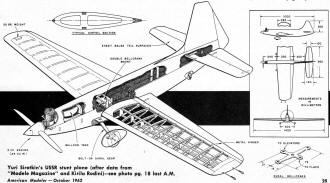
Yuri Sirotkin's USSR stunt plane (after data
from "Modele Magazine" and Kirila Rodini)-see photo pg. 18 last
A.M.
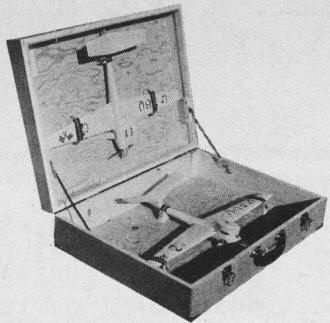
Still at Westchester: Neat case by Roy Tucker
for FAI speed jobs.
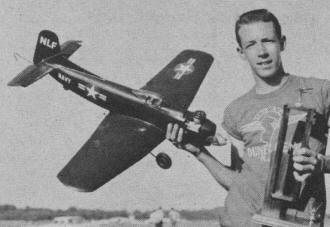
Open Carrier winner Dick Ryan and his Ryan XF2R-1,
McCoy 60, 109-mph Dark Shark.
Requisite for Ideal RR Pilot. (A) Arm from top of head (only
one required) with strong oversize muscle for whipping. (B) Left
leg shorter than right leg to impart natural leaning stance. (C)
Large, flat feet with tough toes. (D) Variable height from 2 feet
to 7 feet for ducking and reaching. (E) At least one hump (a la
camel) since it gets awfully dry out there.
Next Month-The Ideal Stunt Pilot.
Femme Fatale. Accidentally discovered an incentive
for beginners. Bob has resisted CL, while building FF models for
several years. At the Ponca City contest he witnessed two 10 year
old girls flying in the Novice Ukie event. That did it! He picked
up the handle and has been flying heavily since. So, to interest
your sub-teen boys, first interest a sub-teen girl. Fool-proof?
We don't know, for sure.
True Confessions All Round. After welcoming
"Battling Bob" Hatschek aboard, we'd better clarify our own black
marks! I built solid models, flew FF glider, rubber and gas, had
two radio ships (and precious little control), flew indoor models,
outdoor ornithopters and auto-giros, ran boats, chased girls (oops)
and then settled on CL. Like Bob and I've been contending "We're
all one big hobby family".
Toy Airplanes? Letter from a lad who will remain
anonymous asks how to convince parents that models are not a waste
of money and time. First we must wipe out the "toy" stigma, by education
and demonstration of a model's complex nature and worthwhile benefits.
A trip to a good contest might help. Here our work can be seen first-hand
and at its best. Pointing out all of the modelers who are now famous,
successful grown-ups could help. Understand John Glenn was a modeler.
Basically the education and advertising afford the best avenues
for success, but we must present a good picture through media outside
of our own model mags. A tough assignment, but possible.
A Told Tale - Now son. let's watch this fellow's
pre-flight procedure. Notice that he is running his lines out with
a clean rag and talcum powder. They pick up oil and dirt and would
stick without frequent cleaning.
Over in the pits, he had the cowl off checking engine bolts,
head bolts, glo plug, tightened the prop and spinner, examined his
controls for binding. While he was there he looked over his fuel
lines for leaks and cracks.
He's checking his controls now. Notice his helper signaling up,
down and neutral. Seems OK so he checks that his clips are closed.
He'll fuel up now. See, after his fuel overflows, he blocks the
overflow vent and gives it another squeeze. That'll fill the line
up to the needle valve. Now a light prime of fuel in the exhaust
and hook up the plug wires. No, he isn't kissing it, he's blowing
into the exhaust to vaporize the fuel. Guess he flooded his plug.
Now notice the signal to the judges and watch that propping hand.
A good hard flip and she's purring. He'll leave the plug wires hooked
up for about 10 seconds while the engine gets warm, and then he'll
listen for a few seconds after disconnecting to be sure it stays
hot, and that it's set right.
There he goes out for the handle. Seems calm doesn't he, like
he's done it before. See how he checks around the circle to make
sure it's clear. Now the hand signal for release. Notice how smoothly
it rolls out with neutral control.
An easy climb to 5 feet and - oops.
Why did it land so soon? Guess he grabbed the handle upside down.
Oh well, let's go over and watch Combat.
FAI TR Bodies Ready. Bob Watts, Liberty, Mo., has cast fiberglass,
red, white and blue FAI TR fuselages and matching cast alum pan.
Write him for info. We're building around one now.
Down By The Old Mill (Cha·Cha·Cha). (1) To gain
one MPH with a given prop you must gain the following additional
RPM: 4"-264; 5"-210: 6"-175; 7"-150; 8"-132"; 9"-117; 10"-105; 11"-96;
12"-88. All this assumes the same prop and airplane combo. Gets
tough later.
2) Fast Fill for Rat and Team Racers available. John Barr got
his rubber filler attachment manufactured. Fits into a 1/2" OD tube
and enables a one-plunge fill for pressure tanks. Construction similar
to a duck call (so we tried it and attracted one irate blue jay).
Word of warning. Operate clean, since a hunk of sand or gravel could
hold the lips open and lose your seal. Device is not limited to
pressure tanks - we're also using it in a non-pressured quick-fill
system. Very good item, well worth the 50c tab.
3) Supertigre G. 21/35 was given the acid test in competition.
After 1/2 hour on bench, slipped into the "Goofer" RR for flight
break-in. Started runs at 85-mph on rich side with 12% Nitro and
29% oil fuel on 8 x 8 Tornado Nylon prop. The engine was so reliable
about hot starting and so steady in the air we decided to use it
at Wichita. During two weeks we flew about 20 miles a nite with
L. H. Hoff doing the honors in the pit. At contest time we had about
2 1/2 hours (not broken-in by ST's standards) but the consistent
94-mph speed sounded good enough. It was. In short, during 70 lap
qualifying our time of 4:03 was high, and our winning 140 lap time
of 7:36 was 1:30 better than second. (Not 6:13 by any means, but
79-mph avg with LeMans start ain't hay.) The engine obviously has
more in it since with MM fuel and Johnson plug it still runs on
the cold side. The other 1/2 hour will help, and with 100-mph speed
and pit stops with fast fill, should knock off some time. The ST
people won't appreciate my using their Combat 35 in RR when they
provide a 40 for such going on, but for my money it will do. All
this with the teeny 0.185 dia venturi insert. Consistency and hot
performance aren't always contained in the same engine, but this
one has 'em.
Thought for the Month. The hurrier you go, the
behinder you get!
Posted July 4, 2015
|